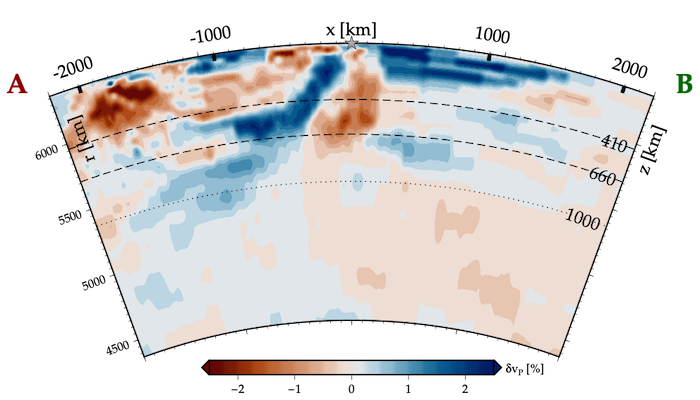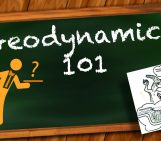
Science is all about discovering new things. But how do we make these discoveries, adding to the ever growing pantheon of knowledge? This week, we sit with one of our editors Antoniette Greta Grima, a Postdoctoral Fellow from the University of Texas at Austin, to understand what it takes to discover a new slab process.
Thanks for sitting down with us this week! First things first, which subduction processes are you interested in?
I’m interested in understanding how deep subduction processes shape the surface and how the surface in turn can affect the slab evolution of the mantle transition zone. In particular, I’m interested in how our interpretation of the surface is understood by the deep slab signatures.
Why are these processes important?
Subduction is ubiquitous on Earth, it is one of the main drivers of plate tectonics and is key for our planet’s habitability. However, the link between deep subduction processes and surface evolution both at the present day and in the past is still unclear. As evidenced by long-lived subduction zones (e.g. the Andean margin, and the subduction under the NW margin of the US), deep slab dynamics can have an important contribution to the long term surface deformation and can directly shape the long term plate motions and configurations.
When we’re trying to interpret past tectonic signatures, past plate configurations or the evolution of topography and surface deformation at subduction zones, some of the pieces of evidence we can use come from geology. We want to link the evolving tectonic regimes with the deep slabs we see in the tomography.
How can we study these processes?
Surface geology (such as geochemical signatures, stratigraphy and thermochronology) is the most direct, evidence based approach. But this information is often limited in space and time, it can be overprinted, or suffers from survivor bias. To help us gain a better understanding of the present day surface observables, we can look at seismic tomography. Seismic imaging provides a present day snapshot of the state of the mantle and the subducting slabs within it. However, understanding the link between the geological evidence and seismic tomography models can be unclear, particularly the further back in time we want to travel. We can bridge the gap through high-resolution, state of the art subduction models. Through these models we can incorporate the data from geology and lab experiments and solve the physical equations that allows our models to evolve self consistently. This can help us build a more complete picture of how subduction zones evolve and how slab dynamics can shape the present day slab morphology.
How do you study these processes? What are the pros and cons of this method?
I use high resolution 2D numerical models of subduction. These simulations are self consistent and include surface topography that evolves realistically with the model evolution. The advantage of these models is that they allow us to observe processes that take place deep within the Earth over many millions of years. These simulations can include different levels of complexity and allow us to isolate and better understand the interactions between different parameters. However, the Earth is a very complex system and every model (no matter how complex) will always be a simplification of reality. In this case our models do not take into account the effects of the sphericity of the Earth, lateral heterogeneities or geometry effects associated with a 3D slab. We also make other assumptions to simplify our models; we start with an established subduction zone, exclude the effects of melt and chemical heterogeneity and we base our rheology and phase transitions on olivine. Lastly we also model a slab subducting into a pristine mantle without any other slab material in it. This allows our models to run within a reasonable amount of time and computational cost.
How did you discover the process of ‘Orphaning’? What is it?
Orphaning is when slab fragmentation occurs deep within the mantle (at 660 km depth) independent of any surface process. Previous to Orphaning, the only mechanisms known to break slabs were shallow depth processes related to changing plate kinematics and followed by subduction termination. Orphaning also links the two end member slab morphologies observed in seismic tomography – flattened and penetrative slabs. This is because slab orphaning allows slabs penetrating into the lower mantle to switch to a flattened mode, answering one of the longest long lived questions in the field: Are penetrative and flattened slabs linked and if so how?
Originally we did not set out to study Slab Orphaning, and when we first saw this slab behaviour we thought that something had gone wrong in our models! However Orphaning persisted even after rigorous testing and exploring multiple setups to ascertain that everything was set up and working correctly. At this point we could not ignore that this was new, never modelled before slab behaviour and that it could help explain some of the most enigmatic features observed deep beneath the oldest subduction zones on Earth.

Figure 3:Slab Orphaning lies between the endmember penetrating and flattening morphologies and fills the gap in the subduction regime space (Grima et al., 2021).
Why is orphaning an important mantle process? What can orphaning tell us about the history of subduction?
Previously the assumption was that the deep isolated slab fragments observed at long lived subduction zones were associated with shallow slab break off (at depth < 300km) through processes such as the decapitation of a slab by a continental keel or subduction of a ridge. The presence of other slab material lying on top of the slab fragment is then interpreted as the result of subduction re-initiation at the same trench following surface plate reorganisation. This interpretation requires frequent overhauls in surface tectonic regimes and is based on assumptions such as stationary trenches, which does not always hold true with observations. Orphaning provides an alternative interpretation where slab breakoff occurs at depth without the cessation of subduction at the trench. This allows for long-lived, continuous subduction without the need of ‘stop-start’ tectonics. Orphaning therefore has important implications for the paleo plate kinematics, plate reconstructions and the timing of island arc accretions. Furthermore, orphaning also provides one way through which subducted slabs deep within the mantle can switch modes from the end member penetrating to flattened morphologies observed in seismic tomography.
What advice would you give to the scientist out there looking to discover something new?
We never planned on coming across Orphaning in our models, we were actually looking for something else. We saw this process in our models and thought ‘oh this is really interesting, why is this happening?’ And by trying to understand what and why this was happening, we made a new discovery. The advice is to be curious! If something looks interesting or odd, always be curious and look into it! It could be a mistake and it’s nothing interesting. Then you can fix it and you’ve learned something. Or it’s something really interesting and it could help the entire community understand a new phenomenon or process.
References
Fukao, Y. and Obayashi, M., 2013. Subducted slabs stagnant above, penetrating through, and trapped below the 660 km discontinuity. Journal of Geophysical Research: Solid Earth, 118(11), pp.5920-5938. doi: 10.1002/2013JB010466
Grima, A.G., Lithgow-Bertelloni, C. and Crameri, F., 2020. Orphaning Regimes: The missing link between flattened and penetrating slab morphologies. Frontiers in Earth Science, 8. doi: 10.3389/feart.2020.00374
Obayashi, M., Yoshimitsu, J., Nolet, G., Fukao, Y., Shiobara, H., Sugioka, H., Miyamachi, H. and Gao, Y., 2013. Finite frequency whole mantle P wave tomography: Improvement of subducted slab images. Geophysical Research Letters, 40(21), pp.5652-5657. doi: 10.1002/2013GL057401





